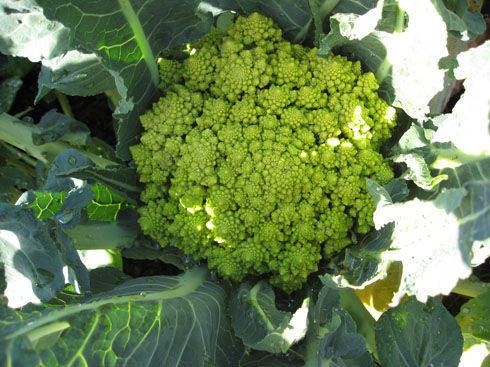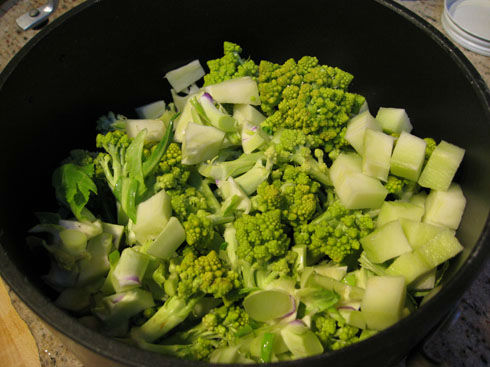Growing new varieties each season keeps the garden interesting. Since we focus on heirlooms and open pollinated varieties here at Gardenerd, our choices are not new, but rather newly discovered. After a slight seed debacle last year where we grew seeds from an (unnamed) seed company that purchased Romanesco seeds from an untrustworthy supplier, resulting in Romanesco that looked nothing like Romanesco, we tried again this year with guaranteed seed.
What a success!

A Romanesco head just starting to separate, about 6″ in diameter
Romanesco broccoli is a bright chartreuse addition to the garden in fall (in warmer climates) or cool spring. Its leaves are Jurassic in size, so it needs some room (that said, we still planted ours 12″ apart). The leaves are edible, but you may want to choose smaller leaves or cut out the stem of larger leaves.
Like cauliflower, it can be tricky to get the plant to form a head. We have broccoli, cauliflower and Romanesco growing in the same bed, and our broccoli and Romanesco headed up, but the cauliflower didn’t. We’re still holding out, but the outlook isn’t good. Research shows that too much nitrogen can cause leafy growth with no head, but our garden tends toward nitrogen deficiency, so I’m guessing we need more phosphorus for better fruit and flower production.
Do the Math
In addition to being a beautiful addition to the garden, Romanesco broccoli provides a math lesson for students and adults who don’t get cross-eyed thinking about math. It’s a great example of Fibonacci numbers and fractals. Fibonacci numbers are a series of numbers, invented/discovered by Leonardo Fibonacci, where “each number after 1 [is] equal to the sum of its two predecessors.” That quote comes from a great website that uses Romanesco and sunflowers (you could use pineapples too) to explain the series:
http://scienceray.com/mathematics/leonardo-fibonacci-a-natural-growth-of-mathematics/
Harvesting
To harvest Romanesco, pick the entire head before it starts to separate (not like our photo above, which was a day or two late). Heads should feel tight and compact when you squeeze them. Picking late doesn’t reduce the flavor of the broccoli, it just opens it up to aphid infestation. One of the beautiful things about Romanesco is that it is so tightly formed, aphids can’t get in.
Cooking
Romanesco is reported to be less bitter than cauliflower and broccoli. We found ours to be very sweet and delicious. Since it was our first harvest, we prepared it simply to experience the flavors.

Chopped stems and florets drizzled with olive oil, salt, pepper, red pepper flakes and a little garlic powder
Put about a 1/4″ of water at the bottom of the pan, cover and bring to a simmer. Set your timer for 5 minutes then serve immediately.
We served it up with some hoisin-glazed tempeh and a brown rice / pearled barley combo.

Romanesco is a beautiful heirloom that can enhance any garden. It’s also a great conversation piece. If you’ve grown it, share your experiences with us here.








Hi there ???? i know I’m a tad late to the conversation, but i came across your page while looking for asvice on when to harvest my romanesco broccoli. I just picked it as it was a bit loose (you said it should be tight) and the florets were starting to get a purple tinge to them (someone else here had a pink thing going on with theirs – weird!). Anyway, i planted my 10 broccolis waaaaay to close together so they’ve all struggled for space and light, so it’s amazing any have headed. This is my first time growing broccoli. I planted seedlings early April (early autumn Australia), so this one took 4 months, but all my others are only tiiiiiny heads so far, so i shall be waiting for a while longer, & after reading all these posts i shall persevere with patience! I don’t know if i can attach a pic to my comment, but just wanted to say thanks so much for your info and happy gardening ???? paula xo
Just some more feedback for everyone-
I started my romanesco from seed in April, put it in the ground at the end of May and it grew and grew past 2 feet tall by July. It was attacked by worms constantly even though I sprinkled with flour and cayenne weekly but one of my plants stuck i out and just this week I have a head on it! That’s 7 months and… Success!
From Coatesville, PA
A hard-won victory, indeed! Congratulations on your 7-month Romanesco. Try floating row cover to keep those cabbage worms at bay next time and I think you’ll find it an easier road. Persistence is key, and you’ve obviously got plenty of it.
I planted my romanescro as a seed started outdoors in late march. Will I get anything this year? The plants are about 3 ft tall but no sign of a head.
Hi Ann, if it’s 3 feet tall then it most likely is bolting, but it probably won’t set a head. I recommend starting the seeds indoors and growing them in the fall instead of spring if your climate allows. Like other brassicas, romanesco likes cool weather to mature, so if it got hot in your area early this year, that could account for it not setting a head. Other reasons include a nutrient deficiency, such as phosphorus or potassium (both help with fruiting, flowering and overall vigor). Don’t despair, try again in well amended soil and see what happens.
Mine is turning pink too!!!!! Can’t find any info anywhere it must be “sunburned” like the cauliflower. Still a beautiful plant cannot wait to harvest!
Hmmm, I haven’t seen that before, but I’m guessing that Romanesco has some of the photo-sensitivity that cauliflower does. If cauliflower is exposed to the sun, it starts to turn yellow. Perhaps this is Romanesco’s way of doing the same. I didn’t find anything specific on the web, so that’s my best guess.